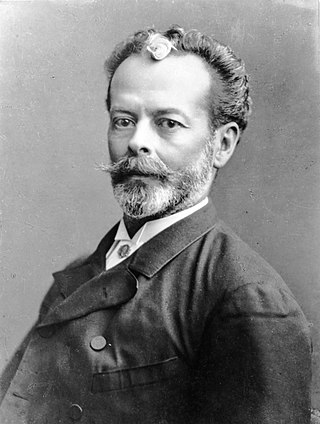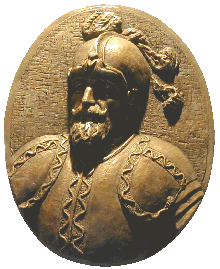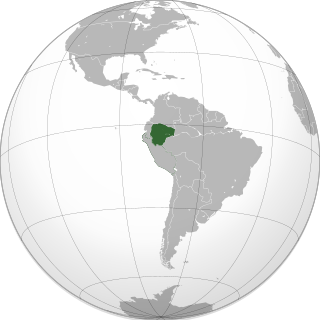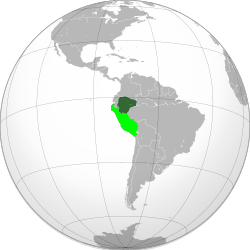The history of Peru spans 10 millennia, extending back through several stages of cultural development along the country's desert coastline and in the Andes mountains. Peru's coast was home to the Norte Chico civilization, the oldest civilization in the Americas and one of the six cradles of civilization in the world. When the Spanish arrived in the sixteenth century, Peru was the homeland of the highland Inca Empire, the largest and most advanced state in pre-Columbian America. After the conquest of the Incas, the Spanish Empire established a Viceroyalty with jurisdiction over most of its South American domains. Peru declared independence from Spain in 1821, but achieved independence only after the Battle of Ayacucho three years later.

Moyobamba or Muyupampa is the capital city of the San Martín Region in northern Peru. Called "Santiago of eight valleys of Moyobamba" or "Maynas capital". There are 50,073 inhabitants, according to the 2017 census. Some 3,500 species of orchids are native to the area, which has led to the city's nickname of The City of Orchids. The city is the capital of both Moyobamba Province and Moyobamba District.

Iquitos is the capital city of Peru's Maynas Province and Loreto Region. It is the largest metropolis in the Peruvian Amazon, east of the Andes, as well as the ninth-most populous city in Peru. Iquitos is the largest city in the world that cannot be reached by road that is not on an island; it is only accessible by river and air.

Loreto is Peru's northernmost department and region. Covering almost one-third of Peru's territory, Loreto is by far the nation's largest department; it is also one of the most sparsely populated regions due to its remote location in the Amazon Rainforest. Its capital is Iquitos.

Jose Nicolás Baltasar Fernández de Piérola y Villena was a Peruvian politician and Minister of Finance who served as the 23rd and 31st President of the Republic of Peru, from 1879 to 1881 and 1895 to 1899.

José Balta y Montero was a Peruvian soldier and politician who served as the 19th President of Peru from 1868 to 1872. He was the son of John Balta Bru and Agustina Montero Casafranca.

Eduardo López de Romaña y Alvizuri served as the 32nd President of Peru from September 1899 to September 1903.

Maynas is one of the eight provinces in the Loreto Region in northeastern Peru. Its capital, Iquitos, is also Loreto's regional capital and the largest city in the Peruvian Amazon Rainforest.

Yurimaguas is a port town in the Loreto Region of the northeastern Peruvian Amazon. Historically associated with the Mainas missions, the culturally diverse town is affectionately known as the "Pearl of the Huallaga". Yurimaguas is located at the confluence of the majestic Huallaga and Paranapura Rivers in the steamy rainforests of northeastern Peru. It is the capital of both Alto Amazonas Province and Yurimaguas District, and had a population estimated at about 62,903 inhabitants (2017).

The Peruvian Army is the branch of the Peruvian Armed Forces tasked with safeguarding the independence, sovereignty and integrity of national territory on land through military force. Additional missions include assistance in safeguarding internal security, conducting disaster relief operations and participating in international peacekeeping operations. It celebrates the anniversary of the Battle of Ayacucho (1824) on December 9.

Alonso de Alvarado Montaya González de Cevallos y Miranda (1500–1556) was a Spanish conquistador and knight of the Order of Santiago.

After the naval campaign of the War of the Pacific was resolved, the Chilean terrestrial invasion began.
The cinema of Iquitos, also known as Amazonian cinema, is an important film development and one of the historic pioneering event of cinema of Peru. Due to the rubber boom and the arrival of foreigners, film interest began in the early 20th century, along with the evolution of cinema of the United States in Hollywood. Cinema in Iquitos had no established date of origin. The first film, however, was made in 1900. The first films were shown in the Casa de Fierro with an Edison machine, which reproduced the images using a carbide lamp and the constant movement of the operator. Iquitos is mentioned as a metonym of cinema in the Peruvian Amazon.

Loretan Insurrection of 1896 was a rebellion of the population of the Department of Loreto against the government of Peru, fought from 2 May 1896 to 10 July 1896. During the insurrection, the population demanded federalization of Peru, and the reformation of Loreto into the autonomous state, which lead to self-proclamation of Federal State of Loreto, de facto autonomous region within Peru. On 10 July 1896, the rebellion was defeated by the government forces and the Federal State was disestablished.

The Jungle Nation, also known as the Jungle Republic, was an unrecognised state, that existed between 1899 and 1900, in the modern territory of Peru, within the departaments of Loreto, San Martín, and Ucayali. It was proclaimed on 22 May 1899, by colonel Emilio Vizcarra, who then acquired the title of the Supreme Leader. The state was formed from the territory of Department of Loreto, Peru. It was reincorporated into Peru in 1900, shortly after the death of Vizcarra on 27 February 1900.

The Federal State of Loreto was an unrecognised self-proclaimed federated state within Peru that was proclaimed during an insurrection in 1921 headed by Peruvian captain Guillermo Cervantes. It was formed from the Department of Loreto and existed as de facto autonomous region of the country. It was dissolved in 1922, after the rebellion was crushed by Peruvian forces. The state was one of many attempts proclaimed in order to gain more autonomy for the region as well as reform Peru into a federal state. Its capital was Iquitos.

Guillermo Cervantes Vásquez was a Peruvian captain and leader of the Peruvian army who formed the group of Veterans of Caquetá that fought in the 1911 La Pedrera Conflict against Colombia, better remembered for his insurrection in 1921 where he proclaimed the Third Federal State of Loreto, one of many attempts to transform Peru into a federal state.

The Colombian–Peruvian territorial dispute was a territorial dispute between Colombia and Peru, which, until 1916, also included Ecuador. The dispute had its origins on each country's interpretation of what Real Cedulas Spain used to precisely define its possessions in the Americas. After independence, all of Spain's former territories signed and agreed to proclaim their limits in the basis of the principle of uti possidetis juris, which regarded the Spanish borders of 1810 as the borders of the new republics. However, conflicting claims and disagreements between the newly formed countries eventually escalated to the point of armed conflicts on several occasions.

The Peruvian resistance movement was composed of the Peruvian militias and guerrillas commanded by local, civilian or military leaders, who confronted the Chilean Army and Navy during the period of occupation that took place during the War of the Pacific.

















